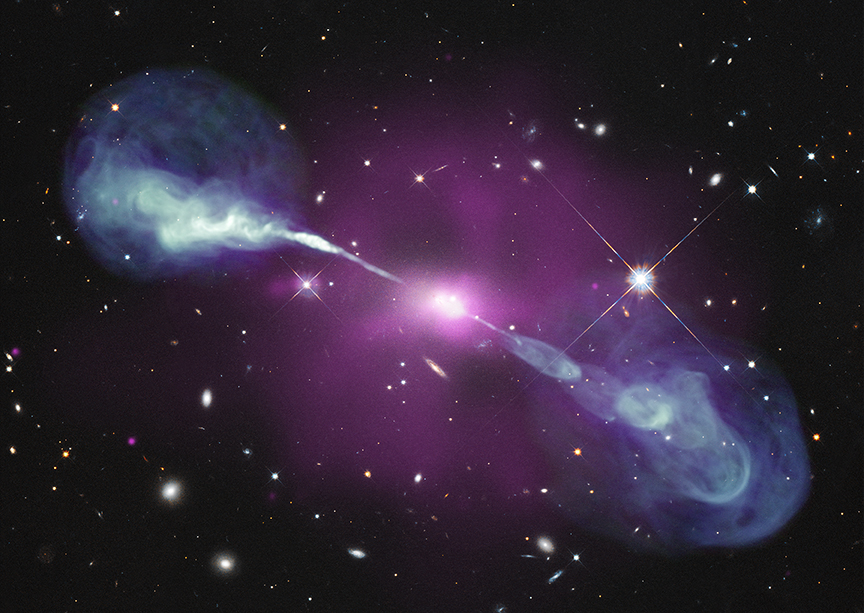
 Credit: X-ray: NASA/CXC/SAO, Optical: NASA/STScI, Radio: NSF/NRAO/VLA)
Credit: X-ray: NASA/CXC/SAO, Optical: NASA/STScI, Radio: NSF/NRAO/VLA)
Out of the Heart of Darkness
Enormous black holes contain more mass than an entire galaxy squeezed into a space no bigger than our solar system. They grow more massive (and proportionally larger) by swallowing nearby material (gas, dust, stars, solar systems). This exotic process is similar to the everyday experience of an object falling down an enormous hill, converting its gravitational potential energy to energy of motion, faster and faster. The main difference is that an object falling into a black hole falls through the boundary of time and space, the black hole's event horizon, never to be seen or heard from again. This cataclysmic accretion process releases an enormous amount of energy, making supermassive black holes among the most powerful engines in the cosmos. Supermassive black holes tend to be found in the centers of galaxies, either because they grow in place there or they fall there. Even our own Milky Way has a (relatively speaking) puny version of one, weighing in at only 4 million times the Sun's mass with a "size" less than 200 times the radius of Jupiter. The image above shows a composite optical, radio and X-ray image of the famous active galaxy Hercules A. Hercules A looks like a run-of-the-mill elliptical galaxy through an optical telescope, but if you look at it with a radio telescope you see two enormous, narrow beams of high-energy particles and radiation radiating from the center of the galaxy and the supermassive black hole that lies there. These jets are so long that it takes light generated near the base of the jet a million years to reach the opposite end. An X-ray image from the Chandra X-ray Observatory, shown in purple, reveals an enormous cloud of hot gas surrounding Hercules A. This gas is heated to temperatures of millions of degrees by the enormous energy streaming from the supermassive black black hole at the center of Hercules A. As a black hole receives, so does it give.
Published: April 6, 2020
<
HEA Dictionary ● Archive
● Search HEAPOW
● Other Languages
● HEAPOW on Facebook
● Download all Images
● Education ● HEAD
>

Each week the HEASARC
brings you new, exciting and beautiful images from X-ray and Gamma ray
astronomy. Check back each week and be sure to check out the HEAPOW archive!
Page Author: Dr. Michael F. Corcoran
Last modified Monday, 26-Feb-2024 17:10:31 EST


